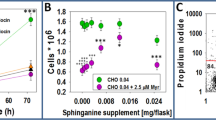Abstract
Fumonisins are specific inhibitors of ceramide synthase in sphingolipid metabolism. An alteration in sphingolipid metabolism as a result of fumonisin exposure is related to cell death (Yooet al., 1992). The objective of this study was to investigate whether elevated free sphinganine levels are related to the sensitivity of cultured cells to fumonisin exposure. Fumonisin B1 elevated the intracellular free sphinganine concentrations in both LLC-PK1 and Chinese hamster ovary (CHO) cells. However, CHO cells are resistant to fumonisin cytotoxicity at 50 μM, while LLC-PK1 cells are sensitive at concentrations greater than 35 μM. The intracellular concentration of free sphinganine in LLC-PK1 cells treated at 50 μM fumonisin B1 for 72 h was approximately 1450 pmol/mg protein relative to the 37 pmol observed in the control culture. Under the same conditions, the population of apoptotic cells in the 50 μM fumonisin B1-treated culture was approximately 37% of the total compared to 12% in the control. The caspase III-like activity after 72 h in the 50 μM fumonisin B1-exposed culture increased to approximately 50 pmol/mg protein/hr compared to 6 pmol/mg protein/hr in the control. L-cycloserine, a serine palmitoyltransferase inhibitor, reduced the fumonisin B1-stimulated caspase III-like activity down to the control level. Under the same culture conditions, the intracellular concentration of free sphinganine after L-cycloserine plus fumonisin B1 treatment was 140 pmol/mg protein compared to 1450 pmol/mg protein in fumonisin B1 alone. The intracellular concentration of free sphinganine in CHO cells treated with 50 μM fumonisin B1 for 72 h was approximately 460 pmol/mg protein, indicating that the mass amount of elevated free sphinganine in the CHO cells was about 32% of that in LLC-PK1 cells. Adding exogenous sphinganine to the CHO cells along with 50 μM fumonisin B1 treatment for 72 h caused both necrosis and apoptosis. In conclusion, the elevated endogenous sphinganine acts as a contributing factor to the fumonisin-induced cell death.
Similar content being viewed by others
References
Gaver, R. C., and Sweeley, C. C., Methods for methanolysis of sphingolipids and direct determination of long-chain bases by gas chromatography.J. Am. Oil Chem. Soc., 42, 294–298 (1965).
Hla, T., Lee, M.-J, Ancellin, N., Liu, C. H., Thangada, S., Thompson, B. D., and Kluk, M., Sphingosine-1-phosphate: extracellular mediator or intracellular second messenger?Biochem. Pharm., 58, 201–207 (1999).
Merrill, A. H., Jr., Wang, E., Mullins, R. E., Jamison, W. C., Nimkar, S., and Liotta, D. C., Quantitation of free sphingosine in liver by high performance liquid chromatography.Anal. Biochem., 171, 373–381 (1988).
Merrill, A. H., Jr., Schmelz, E.-M., Dillehay, D. L., Spiegel, S., Shayman, J. A., Schroeder, J. J., Riley, R. T., Voss, K. A., and Wang, E., Sphingolipids-the enigmatic lipid class biochemistry, physiology, and pathophysiology.Toxicol. Appl. Pharmacol., 142, 208–225 (1997).
Nair, M. G., Fumonisins and human health.Ann. Trop. Paediatr., 18. S47–52 (1998).
Norred, W. P., Bacon, C. W., Plattner, R. D., and Vesonder, R. F. Differential cytotoxicity and mycotoxin content among isolates ofFusarium moniliforme.Mycopathologia, 115, 37–43 (1991).
Riley, R. T., An, N. H., Showker, J. L., Yoo, H.-S., Norred, W. P., Chamberlain, W. J., Wang, E., Merrill, A. H., Jr., Motelin, G., Beasley, V. R., and Haschek, W. M. Alteration of tissue and serum sphinganine to sphingosine ratio: An early biomarker of exposure to fumonisin-containing feeds in pigs.Toxicol Appl. Pharmacol., 118, 105–112 (1993).
Riley, R. T., Hinton, D. M., Chamberlain, W. J., Bacon, C. W., Wang, E., Merrill, A. H., Jr., and Voss, K. A. Dietary fumonisin B1 induces disruption of sphingolipid metabolism in Sprague-Dawley rats: A new mechanism of nephrotoxicity.J. Nutr., 124, 594–603 (1994a).
Riley, R. T., Wang, E., and Merrill, A. H., Jr. Liquid chromatography of sphinganine and sphingosine: use of sphinganine to sphingosine ratio as a biomarker for consumption of fumonisins.J. Assoc. Off. Anal. Chem. Int., 77, 533–540 (1994b).
Shier, W. T., Abbas, H. K., and Mirocha, C. J. Toxicity of mycotoxins fumonisins B1 and B2 andAlternaria alternata f. sp.Lycopersica toxin (AAL) in cultured mammalian cells.Mycopathologia, 116, 97–104 (1991).
Smith, P. K., Krohn, R. I., Hermanson, G. T., Mallia, A. K., Gartner, F. H., Provenzano, M. D., Fujimoto, E. K., Goeke, N. M., Olson, B. J., and Klenk, D. C. Measurement of protein using bicinchoninic acid.Anal. Biochem., 150, 6–85 (1985).
Turner, P. C., Nikiema, P., and Wild, C. P., Fumonisin contamination of food: progress in development of biomarkers to better assess human health risks.Mutat. Res., 443, 81–93 (1999).
Wang, E., Norred, W. P., Bacon, C. W., Riley, R. T., and Merrill, A. H., Jr. Inhibition of sphingolipid biosynthesis by fumonisins: Implications for diseases associated withFusarium moniliforme.J. Biol. Chem., 266, 14486–14490 (1991).
Wang, E., Ross, P. F., Wilson, T. M., Riley, R. T., and Merrill, A. H., Jr. Alteration of serum sphingolipids upon dietary exposure of ponies to fumonisins, mycotoxins produced byFusarium moniliforme.J. Nutr., 122, 1706–1716 (1992).
Yoo, H., Norred, W. P., Wang, E., Merrill, A. H., Jr., and Riley, R. T. Sphingosine inhibition of de novo sphingolipid biosynthesis and cytotoxicity are correlated in LLC-PK1 cells.Toxicol. Appl. Pharmacol., 138, 211–218 (1992).
Yoo, H., Norred, W. P., Showker, J., and Riley, R. T. Elevated sphingoid bases and complex sphingolipid depletion as contributing factors in fumonisin-induced cytotoxicity.Toxicol. Appl. Pharmacol., 114, 9–15 (1996).
Yoo, H.-S., Norred, W. P., and Riley, R. T. A rapid method for quantifying free sphingoid bases and complex sphingolipids in microgram amounts of cultured cells (LLC-PK1) following exposure to fumonisin B1.Toxicol. in Vitro, 10, 77–84 (1996).
Author information
Authors and Affiliations
Corresponding author
Rights and permissions
About this article
Cite this article
Yu, CH., Lee, YM., Yun, YP. et al. Differential effects of fumonisin B1 on cell death in cultured cells: the significance of the elevated sphinganine. Arch. Pharm. Res. 24, 136–143 (2001). https://doi.org/10.1007/BF02976481
Received:
Issue Date:
DOI: https://doi.org/10.1007/BF02976481




